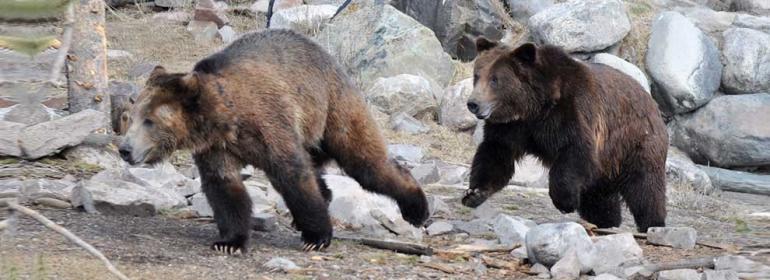Grizzly Discovery Center
It’s 10:00 a.m. on a bright summer day near Yellowstone National Park, and a young golden grizzly bear scampers across the hillside. He tumbles down the bank, landing sideways and ready for his sister to pounce. It’s playtime! We stand only twenty feet away, watching as the two young bears wrestle and roll across the grass. Suddenly, one of the grizzlies lifts his nose to the air. He smells food. In a flash, the cub is clawing through a log pile searching for the source of the smell. He finds and quickly devours the ripe berries. After a few seconds nothing remains, and the grizzly puts his nose to work once again, ursine eyes scouring the hillside for more tasty grub.
This is a typical morning at the Grizzly Discovery Center, West Yellowstone’s unique bear and wolf preserve located just two blocks from Yellowstone Park’s west entrance. It is perhaps one of the greatest tools for educating people about the wildlife seen (and unseen) in the park, and also one of the safest methods of witnessing the ways of the Great Bear.
"The Discovery Center’s primary focus is on wildlife education and habitat conservation," says Education Coordinator Brett Fitzgerald. Eight Brown Bears live at the center, all of which are unable to live in the wild. As prime grizzly habitat continues to disappear, grizzlies still face an uncertain future in the lower forty-eight states – and thus education about their unique behavior and ecological needs is important. "The purpose of the Discovery Center is to encourage wildlife stewardship and appreciation by teaching people about bears and wolves, while offering them an opportunity to view them interacting naturally," explains Fitzgerald.
With this in mind, the bears’ living environment simulates a natural one: they search for their own food (hidden in trees and under logs by staff members), they live in separate dens, they have separate feeding and roaming hours, and they interact with one another regularly. "These bears are ambassadors for all bears in the wild," Fitzgerald continues. "By watching their natural behavior, people develop a better understanding of bears, and why these amazing creatures are worth protecting."
Strolling the winding outdoor paths of the Discovery Center’s sprawling five-acre complex, visitors can listen to informative talks from experienced naturalists as they watch bears and wolves in a controlled, yet very real, outdoor environment. Feeding patterns, habitat requirements, and safety in bear country are just some of the topics covered by the center’s knowledgeable staff.
Ten wolves make up the Discovery Center’s Gallatin Pack. These long-legged, majestic animals arrived at the Center in 1995. According to Fitzgerald, the reintroduction program in the Greater Yellowstone Ecosystem is exceeding expectations: as of the latest estimate, there are nearly 170 wolves making up 16 different packs. Occasionally people see these wolves, though they are elusive creatures that tend to shy away from humans. Yet, by visiting the Discovery Center, one can not only see a 120-pound gray wolf up close and personal, but also learn about its history and behavior.
The Grizzly Discovery Center opened its doors in 1993, and last year became a not-for-profit organization. With this new designation come some powerful conservation strategies. Several new educational efforts will take place this summer, with the GDC offering a range of exciting programs. For information, or for GDC hours and admission fees, call (406) 646-7001, or check out their Web site at www.grizzlydiscoveryctr.com.






